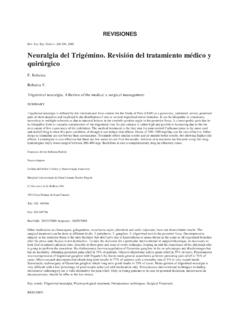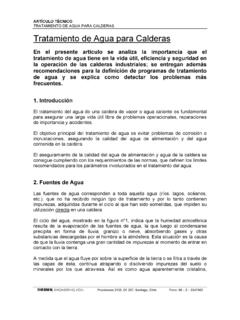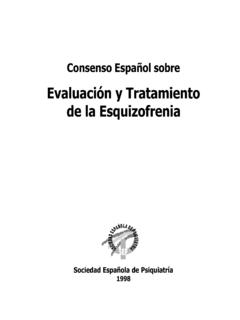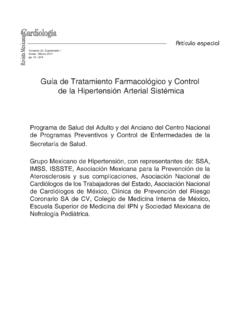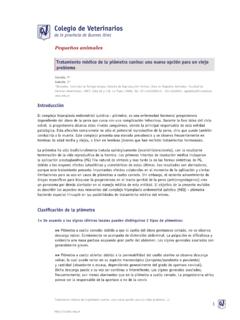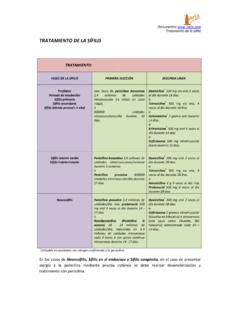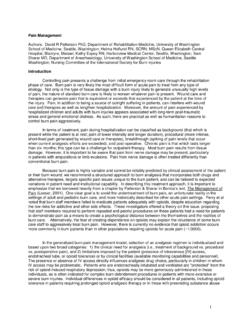Transcription of CONSTRUCTED WETLANDS TO TREAT …
1 wastewater GARDENS INTERNATIONAL INFORMATION SHEET IS20120105 CONSTRUCTED WETLANDS TO TREAT wastewater FRAMEWORK AND SCHEMATIC OVERVIEW WWG Information Sheet About CONSTRUCTED WETLANDS page 2 / 26 Index Photo gallery p. 3 CONSTRUCTED wetland (CW): Definitions and Terminology p. 4-5 Types of CONSTRUCTED WETLANDS p. 6 Schematic piping and basic hydraulics in Subsurface Flow CONSTRUCTED WETLANDS p. 7 Examples of bio-geo-chemical cycles in a wetland p. 8 wastewater Contaminants Removal Mechanisms in WETLANDS p. 9-13 CONSTRUCTED wetland filter media p. 14 Essential Design Considerations p. 15-16 Advantages and Inconvenient of CONSTRUCTED WETLANDS to TREAT wastewater p. 17-18 Case study Community of 8,000 habitants p.
2 19-21 Installation process (of a small unit) p. 22-26 WWG Information Sheet About CONSTRUCTED WETLANDS page 3 / 26 PHOTO GALLERY 11,000 m3/day gasoline contaminated water, BP, USA(tbc) Municipal wastewater Treatment plant (6000 m2), Koh Phi Phi Don, Thailand): 400 m3/day: Organic water: 3,000 4,000 permanent residents + million tourist/year Partial view of municipal STP, Honfleur, France: 3-5,000 m3/day, 26,000 habitants Xu-Park Eco Park, Hotel + Restaurant, 1500 guests + visitors/day Private residence, 6 habitants, Bali, Indonesia Offices , 45 persons (BAPEDALDA Govt. Agency), CW treating toilet/faecal water only * Note: unit recently planted Tirta Gangga Royal Water Gardens, public park, 300 visitors/day (treating toilet/faecal water), Bali, Indonesia WWG Information Sheet About CONSTRUCTED WETLANDS page 4 / 26 CONSTRUCTED wetland (CW): DEFINITIONS " CONSTRUCTED treatment WETLANDS are engineered systems, designed and CONSTRUCTED to utilise the natural functions of wetland vegetation, soils and their microbial populations to TREAT contaminants in surface water, groundwater or waste streams 1 + 2.
3 Synonymous terms of CWs include: Man-made, engineered, artificial or treatment WETLANDS . There are also a number of terms used for subsurface flow CWs, which can be confusing for novices: Planted soil filters: Their vegetation is composed of macrophyte plants from natural WETLANDS and this sets them apart from the unplanted soil filters, also called subsurface biofilters, percolation beds, infiltration beds or intermittent sand filters. Reed bed treatment system: A term used principally in the United-Kingdom, Europe, resulting from the fact that the most frequently used plant species is the common reed (Phragmites australis). Vegetated submerged beds, vegetated gravel-bed and gravel bed hydroponics filters.. Phytorestoration: a term covering all technologies using plants to restore soils, ecosystems, and/or water integrity.
4 CONSTRUCTED WETLANDS TREAT the sewage water using highly effective and ecologically sound, design principles that use plants, microbes, sunlight and gravity to transform wastewater into gardens and reusable water. The water treatment mechanisms are biological, chemical and physical, these include physical filtration and sedimentation, biological uptake, transformation of nutrients by bacteria that are anaerobic (bacteria that flourish in the absence of oxygen) and aerobic (oxygen-needing bacteria), plant roots and metabolism, as well as chemical processes (precipitation, absorption and decomposition) that purify and TREAT the wastewater . While the system does not normally use machinery (except pumps if necessary to get wastewater to the CW unit/s against gravity), nor chemicals, the variety of natural mechanisms that do the water recycling and purification make CW very effective.
5 In the case of WWG, our water treatment level often exceeds local Health Authority treatment requirements. When even higher treatment than normal municipal standards is required for special purposes, an increase in wetland area can provide the equivalent of advanced water treatment. Working with Subsurface Horizontal Flow CW, there is no wastewater is exposed on the surface, there are no odours, no mosquito breeding grounds, nor possibility of accidental contact with sewage; furthermore, since most people will only see a beautiful garden, they can be placed near entrances and gathering places, as well as be used as green belts around communities. They are so designed that they can be integrated into existing gardens if there is limited space on the Site and have been proven to be far more effective, economical and long-lasting than conventional sewage treatment systems.
6 3 .. A designed and man-made complex of saturated substrates, emergent and submergent vegetation, animal life, and water that simulates natural WETLANDS for human use and benefits". 4 CONSTRUCTED WETLANDS are an effective, environmentally friendly means of treating liquid and solid waste. CWs could bring major economic benefits to developing countries through the provision of biomass and aquaculture. Such wetland systems can yield a significant profit for local communities, and might be a powerful tool for breaking the poverty cycle. CWs are effective at reducing loads of BOD/COD, nitrogen, phosphorus and suspended solids by up to 98%. However, despite the suitability of climate in developing countries, the spread of WETLANDS in such areas has been "depressingly slow".
7 5 1 ITRC, 2003 - Interstate Technology Regulatory Council WETLANDS Team, USA ( ) 2 Deutsche Gesellschaft f r Internationale Zusammenarbeit (GIZ) GmbH 3 wastewater Gardens International 4 Hammer, 1989. 5 (Denny et al., 1997). Fujjita Research, 1998. WWG Information Sheet About CONSTRUCTED WETLANDS page 5 / 26 CONSTRUCTED wetland (CW): DEFINITIONS (CONT.. / ..) 6: ( CONSTRUCTED WETLANDS ) can be considered treatment systems that use natural processes to stabilize, sequester, accumulate, degrade, metabolize, and/or mineralize contaminants. Although CONSTRUCTED wetland applications were limited to treating primarily storm water and municipal wastewaters, they are now being used in new applications and on new contaminants.. wetland systems have always served as natural water treatment systems.
8 During the past few decades people have seriously studied and utilized wetland systems for meeting wastewater treatment and water quality objectives in a controlled manner. The role of WETLANDS as a passive approach to improving water quality is a compelling argument for preserving natural WETLANDS and, in recent years, constructing WETLANDS systems for wastewater treatment.. CONSTRUCTED wetland treatment systems use rooted wetland plants and shallow, flooded or saturated soil to provide wastewater treatment. CONSTRUCTED WETLANDS are designed to take advantage of the chemical and biological processes of natural WETLANDS to remove contaminants from the wastewater (Skousen 2004).. The technology is now mature and tested. Increasingly, studies have provided evidence that WETLANDS systems can effectively improve water quality while providing many benefits, including food and habitat for wildlife.
9 CONSTRUCTED WETLANDS are proving to be a valid treatment option for acid mine drainage, hazardous waste site wastewaters, petroleum refinery wastes, compost and landfill leachates, agricultural wastes and pre-treated industrial wastewaters, such as those from pulp and paper mills and textile mills (ITRC 2003, USDA 1995).. WETLANDS remove metals using a variety of processes including filtration of solids, sorption onto organic matter, oxidation and hydrolysis, formation of carbonates, formation of insoluble sulphides, binding to iron and manganese oxides, reduction to immobile forms by bacterial activity, and uptake by plants and bacteria. Metal removal rates in both subsurface flow and surface flow WETLANDS can be high, but can vary greatly depending upon the influent concentrations and the mass-loading rate.
10 Removal rates of greater than 90% for copper, lead and zinc have been demonstrated in operating surface flow and subsurface flow WETLANDS .. WETLANDS possess a rich microbial population in the sediment to bring about the biochemical transformation of pollutants, are biologically productive, and are self-sustaining. CONSTRUCTED WETLANDS also have significantly lower total lifetime costs and often lower capital costs than conventional treatment systems (ITRC 2003). Compared to conventional systems, natural systems can be operated using less electricity and less labor (USEPA 1988). 6 Review of CONSTRUCTED Subsurface Flow vs. Surface Flow WETLANDS , Nancy V. Halverson, September 2004, prepared for the Department of Energy.

